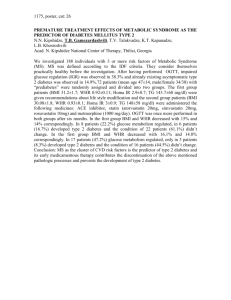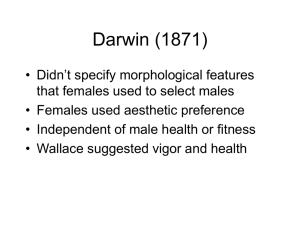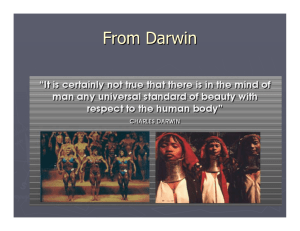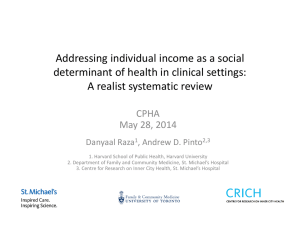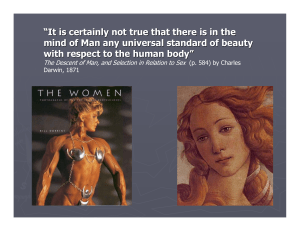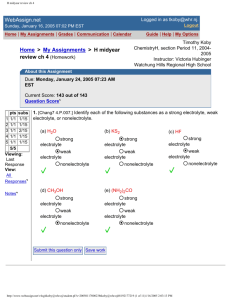Weeks 5 & 6
advertisement
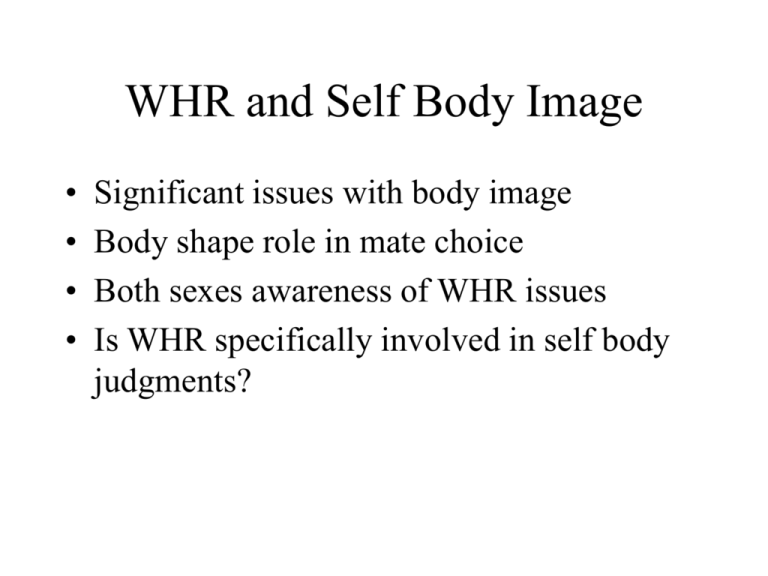
WHR and Self Body Image • • • • Significant issues with body image Body shape role in mate choice Both sexes awareness of WHR issues Is WHR specifically involved in self body judgments? Joiner, Schmidt & Singh (1994) • Depression • Limited earlier work on WHR and body dissatisfaction • Body dissatisfaction had been connected to depression, bulimia, eating disorder Subjects • Undergraduates • Questionnaires – Beck Depression Inventory (BDI) • BMI, WHR, anthropometric indicies Findings: Just WHR • Low WHR corresponds to higher body dissatisfaction • Agreement with Radke-Sharpe et al. (1990) – Large hips and buttocks --> higher body dissatisfaction Findings: Interaction • WHR x BDI x Gender interaction • Body dissatisfaction more complicated Cognitive Theories of Depression • Depressive distortion – Misrepresent own self shape • Depressive realism – Better/more accurate representation of self shape Sexual Dimorphism Identification • Results fit better with depressive realism • Depressed people better at perceiving the reality of what their WHRs convey • Depressed males will be dissatisfied with low WHRs (more gynoid) • Depressed females will be more dissatisfied with high WHRs (more android) WHR as Adaptation • Additional evidence for WHR playing role in mate choice for some time • Involvement with other psychological constructs Focused Attention • Individuals can identify desired sexually selected characteristics in others and self • Predict that you would draw attention to traits if beneficial Singh & Bronstad (1997) • Body scarification • Standard Cross-Cultural Sample (SCCS) – 186 societies – Assess pathogen prevalence, polygyny, degree and location of body scarification in population – Can’t be used to determine individual specifics Sex. Selection & Parasites • Positive correlations between amount of societal scarification and pathogen prevalence • Females more likely to scarify their stomachs and breasts at higher pathogen levels If You’ve Got It, Flaunt It… • High pathogen levels --> overall reduction in potential mates • Much more important to select genotypically fit, healthy mates • Scarification of sexually dimorphic secondary sexual traits draws attention to them • Highlights fitness www.ezakwantu.com/Scarifacation%20Abdoman%2002.jpg www.ezakwantu.com/Scarifacation%20Abdoman%2011.jpg www.ezakwantu.com/Scarification%20Face%2006.jpg Navel Gazing • Female scarification of stomach fits with WHR interpretation • Navel is indicator of natural waistline • Woman who draws attention to desired WHR may gain attention of higher quality males • Other non-scarification ornamentation used to similar purpose – Corsets, belts, shawls, etc. Henss (1995) • Replicated and expanded Singh’s studies • Methodology changes • Between subjects design – Avoid demand characteristics – Each subject only saw and evaluated one figure • Big Five personality factors – Extraversion, agreeableness, conscientiousness, emotional stability, intellect • In all, 51 criteria subjects are assessing on • 72 males, 72 females, Germany Agreement with Singh • Effects of body weight are considerably stronger than those of body shape • Underweight and normal rated more attractive • Overweight least attractive, but most emotionally stable, family oriented, agreeable, and conscientious Differences from Singh • WHR 0.8 most attractive (then 0.7) • Underweight more attractive than normal weight Attractiveness • Singh: “attractive” and “sexy” • Henss: weighted composite of 51 scales – Ran collapsed analysis of 15 scales – Still U>N>O, whereas Singh had N>U>O, but closer • May also be a difference in the within- vs. between-subject design Overall • General agreement with Singh’s findings • Some quibbling over particulars • Body weight and body shape being used in attractiveness judgments Furnham, Tan & McManus (1997) • Singh’s ranked data strictly non-parametric; parametric data more powerful • Used ratings (7 pt. Likert scale) instead of ranking • Participants judged all figures; withinsubject • British subjects Broad Results • • • • Attractiveness: N>U>O Healthiness: N>O>U Youthfulness: U>N>O Overall, WHRs of 0.7 or 0.8 rated most favourably for all factors, regardless of weight Compare and Contrast • Unlike Henss (1995), but like Singh, none of the underweight figures considered most attractive • Normal weight figures rated highest for everything but youthfulness • Across weights, high WHRs rated unattractive, unhealthy, and unyouthful • Like Henss, WHR of 0.8 rated most attractive Contribution • Generally agrees with Singh • Along with Henss, identifying body weight as more significant than body shape in judgments • Still arguing for WHR as adaptive trait in mate choice • Is it first-pass filter, though? Universiality? • By 1997 still general support for WHR • American (Caucasian, Mexican, Black), Indonesian, German, British subjects sampled • But what about non-industrialized? Yu & Shepard (1998) • Yomybato: Matsigenka indigenous people in Manu Park, Peru – Slash and burn agriculture, hunting and gathering – About 300 people in population – Extremely non-Westernized • Shipetiari: Matsigenka people living outside Manu Park – More exposed to Western culture • Alto Madre: ethnically mixed population of Amarakaeri, Huachipaeri, and Piro – Even more Westernized Method • Singh’s figures • Used U7, N7, O7 and U9, N9, O9 figures • Males asked to rank figures from most to least for beauty, health, and marriage preference Results • Yomybato and Shipetiari – Grouped figures by weight first, then WHR – Preferred overweight figures – High WHR more healthy • Shipetiari – Low WHR figures more attractive and desirable as spouses – Didn’t consider healthiest to be most attractive or desirable – “…suggesting that WHR preferences may be changing.” (321) • Alto Madre – Didn’t differ significantly from American judgments – Grouped figures by WHR first, then weight – N7 generally ranked highest – Low WHR figures always ranked higher than high WHR figures Nurturist Account • Argue that Singh’s results are due to Western media • Least Westernized of tribal peoples showed most difference from American population • “…many ‘cross-cultural’ tests in evolutionary psychology may have only reflected the pervasiveness of western media.” (322) • But, no explanation of why Western media would favour low WHRs In Small Populations • With small population sizes, limited mate choices – Few people, kinship, etc. • Individuals would have detailed knowledge of health history of potential mates from long-term personal contact • Physical features may take on secondary role in mate choice Wetsman & Marlowe (1999) • • • • Hadza of Tanzania Mixed savanna, woodland environment Small population of only 1000 individuals 1/3 exclusively hunter/gatherer – Only used males form this group for the study • Hunger not uncommon, but no one can remember anyone ever starving • No one obese Method • U7, N7, O7 and U9, N9, O9 • Forced choice for attractiveness, health, preference for wife • 75 men (18-68 years, mean 37) • Also, American undergrads (24 subjects, mean age 21.2) Results • American undergrads – Same pattern as Singh’s earlier studies • Hadza – No significant preference based on WHRs – Used body weight – Strong preference for overweight, then normal, than underweight for all criteria Environment Input • Suggests WHR a second-pass filter, not first-pass • Propose differing environmental input model • Food scarcity determines hierarchy of selection In Food Scarce Environments • Best option is to use body weight • Survival first, reproduction second • If WHR used first, most attractive, healthiest females may starve before reproducing or never achieve enough fat to be able to reproduce • Even if higher weight conferred some health detriments, higher fat stores preferred – None of Hadza are obese In Food Rich Environments • Risk of starvation low • WHR better predictor • Here too much weight can compromise reproductive fitness Marlowe & Wetsman (2001) • Hadza (and American) males • Asked about: attractiveness, health, desirability for wife • New set of figures • Did not vary in weight • Broader range of WHRs Results • Americans disliked WHR of 0.9 and 1.0 and also 0.4 and 0.5; general preference for WHRs around 0.7 • Hadza preferred higher WHRs (0.8, 0.9, 1.0 all ranked above 0.7) Concordances • Measure of agreement among subjects • Americans: greater concordances for attractiveness and desirability to marry • Hadza: greater concordance for health • For Hadza health determines desirability for marriage; for Americans it is attractiveness Confound • Even with no weight variation, Hadza still preferring high WHR • Artifact of preference for heavier women • BMI confounded with WHR in Singh’s original figures and with current figures – Height is kept constant; as WHR increases from 0.4 to 1.0, so would weight in a real woman – Females with larger waists look heavier Theorizing • Environmental differences • Current fertility status • Different female body shapes Environment • Among foragers, thinness probably indicates poorer health (parasites) • Women who are too thin are energetically stressed • Will interfere with reproduction • High energy demands on Hadza women • Prior to agriculture health-threatening obesity probably very rare • Should have been preference for women with more fat stores Developed Nations • Propose agriculture led to more predictable and surplus food supply (at least for some) • Risk of obesity increased • Men developed preference for low BMIs (and WHRs) Fertility Status • Pregnant women have high WHR • Total fertility (TFR): average number of children produced by a woman in a society • American TFR = 2.1; Hadza TFR = 6.2 • High WHR (pregnant?) – American: bad mate choice (probably only one more child with her) – Hadza: not so bad (up to another 5.2 children) • The lower the TFR the more men favoured for attending to signs of non-pregnancy Different Female Body Shapes • Different populations of humans • Geographical isolation; different phenotypic expressions; fat stores • Health risks of 2D WHR presumed to correlate with “real WHR” measure in 3D • But, two women can have same frontal WHRs, but different actual WHRs Marlowe, Apicella & Reed (2005) • Actual WHR = measurement with tape measure • Frontal WHR = 2D front view • Profile WHR = 2D profile (side) view • Frontal WHR doesn’t reflect buttock size and profile WHR doesn’t reflect hips • Actual WHR reflects both hips and buttocks An Assumption • If relative contributions of hips and buttocks to actual WHR didn’t vary in women crossculturally, then frontal WHR would suffice • Does it? • Er… probably not • Need a new stimulus set to test • Use Hadza and Americans again; attractive, healthy, wife Theoretical Preference • For actual WHR • Based on study preferences • Weighted the profile WHR 0.7 times that of frontal WHR • Theoretically preferred actual WHR = [(preferred frontal x1.0) + (preferred profile x 0.7)] / 1.7 Results • Statistically analyzed men’s first choice preference of five figures for three criteria • Hadza profile WHR selection significantly lower than Americans for all three criteria • Prefer more protruding buttocks than Americans Outcomes • Americans: preferred frontal WHR = 0.7 and profile WHR = 0.65 • Hadza: preferred frontal WHR = 0.9 and profile WHR = 0.6 • Use equation for theoretically preferred actual WHRs • Americans: 0.68 • Hadza: 0.78 Actual Hadza WHR Measurements • Mean actual WHR – Aged 17-82 = 0.83 – Aged 17-24 = 0.79 • Bit higher than other populations, but not the highest • Non-agriculturalists typically have higher female WHRs New Figures, Fuller Analysis • Hadza and American men’s preferences for women’s actual WHRs not as different as previous two studies suggest • Problem with just using frontal WHR Comparison • Hazda women do have higher WHRs than American women • Hadza, 17-24 years, WHR = 0.79 • American, 18-23, WHR = 0.73 • Why the difference? Some possibilities. Parity • WHR does rise with parity (number children born) • Hazda TFR=6.2, average age of first child = 19 • American TFR=2.1, average of first child = 25 Diet • Bulky, fibrous tubers significant in Hadza diet • Require larger gut • Humans aren’t ungulates… Physical Activity • Foragers more energetically active • May favour higher androgen levels, depositing more fat in abdomen • Raises WHR Environmental Selection • High level foragers must be more efficient at locomotion • Pelvis suited for locomotion not optimized for childbirth • Evolutionary trade-off depending on environment • Less for women to forage in colder climates – Further from the equator, the less women need to be optimized for locomotion – Nearer equator, women contribute more resources to diet • Possible male preferences map on to variation in females’ shape Age-Based Selection • WHR reaches trough shortly after menarche • Male preference for WHR may be age-based preference for nubility • Maximization of RV • Actual WHR could vary across populations with variation in population mean postmenarcheal WHR • Hadza males’ preference of 0.78 very close to young females’ WHR of 0.79 • American males’ preference of 0.68 close to WHR of young university aged women’s WHR (0.72-0.73)

